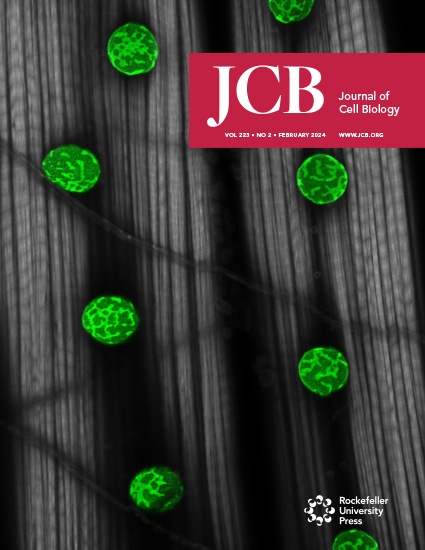RIM and MUNC13 membrane-binding domains are essential for neuropeptide secretion.
IF 7.4
1区 生物学
Q1 CELL BIOLOGY
引用次数: 0
Abstract
Neurons release neurotransmitters from synaptic vesicles (SVs) and neuropeptides from dense-core vesicles (DCVs). The presynaptic proteins RIM and MUNC13 play key roles in both pathways. It remains unclear how DCVs are targeted to release sites and whether RIM and MUNC13 are involved in this process. Here, we show that three membrane-binding domains in RIM and MUNC13 regulate DCV exocytosis differently from SV exocytosis. Using neuropeptide secretion assays with single-vesicle resolution and peptidomics analysis of endogenous neuropeptide release in MUNC13/RIM null neurons, we demonstrate that MUNC13 is essential for DCV exocytosis. The RIM N terminus prevents MUNC13 degradation via the proteasome, and inhibiting proteasomal degradation partially rescues DCV exocytosis in RIM's absence. Unlike SV exocytosis, the PIP2-binding RIM C2B domain and MUNC13 C1-C2B polybasic face are redundant for DCV exocytosis, while the lipid-binding MUNC13 C2C domain is crucial. These results show that RIM and MUNC13 synergistically regulate DCV exocytosis through membrane interactions and reveal new mechanistic differences between SV and DCV exocytosis.RIM和MUNC13膜结合结构域是神经肽分泌所必需的。
神经元从突触囊泡(SVs)释放神经递质,从密核囊泡(DCVs)释放神经肽。突触前蛋白RIM和MUNC13在这两种通路中起关键作用。目前尚不清楚dcv是如何靶向释放位点的,以及RIM和MUNC13是否参与了这一过程。在这里,我们发现RIM和MUNC13中的三个膜结合结构域对DCV和SV胞吐的调节不同。通过单囊解析度的神经肽分泌测定和MUNC13/RIM缺失神经元内源性神经肽释放的肽组学分析,我们证明MUNC13对DCV胞外分泌至关重要。RIM N端通过蛋白酶体阻止MUNC13降解,抑制蛋白酶体降解部分地挽救了缺乏RIM的DCV胞吐。与SV胞吐不同,pip2结合的RIM C2B结构域和MUNC13 C1-C2B多基面在DCV胞吐中是冗余的,而脂质结合的MUNC13 C2C结构域是至关重要的。这些结果表明,RIM和MUNC13通过膜相互作用协同调节DCV胞吐,揭示了SV和DCV胞吐之间新的机制差异。
本文章由计算机程序翻译,如有差异,请以英文原文为准。
求助全文
约1分钟内获得全文
求助全文
来源期刊

Journal of Cell Biology
生物-细胞生物学
CiteScore
12.60
自引率
2.60%
发文量
213
审稿时长
1 months
期刊介绍:
The Journal of Cell Biology (JCB) is a comprehensive journal dedicated to publishing original discoveries across all realms of cell biology. We invite papers presenting novel cellular or molecular advancements in various domains of basic cell biology, along with applied cell biology research in diverse systems such as immunology, neurobiology, metabolism, virology, developmental biology, and plant biology. We enthusiastically welcome submissions showcasing significant findings of interest to cell biologists, irrespective of the experimental approach.
 求助内容:
求助内容: 应助结果提醒方式:
应助结果提醒方式:


